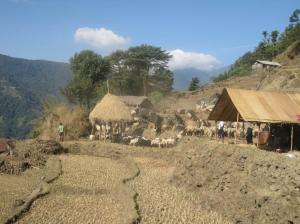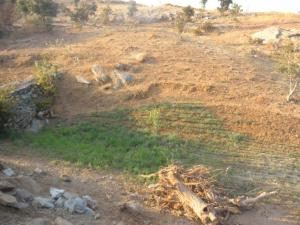By Dr. Hemant R Ojha

Studies show that agriculture is highly affected by climate change and variabilities. But there is a big black hole in our knowledge on the capacity of agricultural systems to adapt to climate change, as the effects cannot be estimated through bio-physical impact modeling alone.
Human beings have always learned to adapt to various forms of adversity and uncertainties. Not surprisingly, agriculture is the sector where humanity has the largest pool of knowledge about managing the environment. Before science came to prominence in the eighteenth century, our farmer ancestors continuously experimented with crops, animals, and techniques of cultivation to cope with diverse environmental risks and difficulties they faced in various epochs and periods.
Beyond traditional knowledge of farmers, agriculture sector has also accumulated complex systems of knowledge through research, extension and innovation – involving government, civic and market institutions.
It is important for us to understand whether changes in agriculture in South Asia are climate adaptive in the longer run, For this, we selected eight case study sites and 14 household survey sites, most overlapping with areas where CCAFS has already been conducting the studies in South Asia. We visited and talked to farmers, agricultural offices, researchers, entrepreneurs and traders, and civil society groups – covering areas from the lower Nepal Himalaya, through Bangladesh floodplains to semi-arid regions of Rajasthan.
Our purpose was to undertake four-step analysis: what changes are taking place in the agricultural practices? What are the connections between such changes and climatic drivers? Can some of these changes be called innovations? Are these innovations climate adaptive?
What changes are taking place?
South Asia has many eco-regions – from the base of Earth’s highest mountains Himalaya to the coastal areas prone to tidal floods. In between are valleys, hill sides, riverbeds, water bodies and alluvial plains.
A number of changes are taking place many of which are innovative and some of which could be climate adaptive as well:
a) The biophysical effect of climate change in South Asia is already significant – not just the commonly noted drought and floods, but also the less noted effects on soil – e.g salinity in South-West bangladesh and ground water pollution in Punjab.
b) But there seems to be a selective perception of climate stress, and a lack of adequate consideration into the full spectrum of climate stress. Strong gaps exist between perceptions of climate change and the adaptive actions among both the farmers and local stakeholders, suggesting the deficit of processes and institutions to translate information into adaptive actions. None of the district agricultural development strategies in the eight study sites in South Asia contain provisions related to enabling agriculture to adapt to climate change.
c) In a variety of situations, especially when farmers have access to services and information, farmers have resorted to innovative practices that are likely to be climate adaptive.
– In north-west Bangladesh, local communities, with the help of NGOs, are reclaiming charland to plant pumpkins, creating floating gardens in the water logged areas with water hyacinth.

– In Lamjung district of Nepal, villagers are experiencing great uncertainties in herding and switching to ecotourism business.
– In Rupandehi and several other sites, farmers are mechanizing farms. When Ramashankar first tried a new technology, his fellow villagers fooled him. But later many followed his path.
– In Rajasthn, an NGO called Sahayog Sansthan has supported community groups to conserve communal pastureland and water conservation. A woman in Rajasthan said: Pani hi pani hai, Jindagi Aram ho gai. This was possible after community initiatives on rain water harvesting, storage and distribution system.
– Rice wheat system in Punjab remained intact due to government support, but facing problems of groundwater shortages and contamination.
– Several soil and water conserving technologies such as zero tillage, happy speeder, laser leveler have improved adaptive capacity of agriculture in Punjab.
– Unlike the usual practice of developing high-yielding varieties, a Bangladesh NGO called RDRS worked with farmers to develop low yield variety to cope with seasonal food deficit (Monga).
– Systems of rice intensification practices in Nalanda district of Bihar has enabled farmers to cope with drought.
– In Madhepura district of Bihar, due to heavy sand deposit, land became unfit for cultivation and one of the strategies adopted by the farmers was to go for cucurbitaceous crops such as parwal, pumpkin and watermelon, based on the advice of the scientists from the Krishi Vigyan Kendra.
a) These potential options should be seen as resulting from dynamic learning and innovation processes that should take place within and around an agricultural system.
b) Ecological rethinking has begun to emerge in terms of reducing straw burning, natural or organic agriculture. But this has not been translated into a bold new strategy of ‘ecologising’ agriculture while maintaining farmers’ benefits.

Are these changes climate adaptive?
There is a tendency to leave the burden of innovation to farmers, and institutions have failed to incentivize farmers on their contributions of environmental and public goods – in terms of enhancing food security, soil conservation, agro-biodiversity management.
Innovation capacity is context-specific and the scales of adaptive capacity are not independent or separate: the capacity of a household to cope with climate risks depends to some degree on the enabling environment of the community, and the adaptive capacity of the community is reflective of the resources and processes of the region.
Adaptation by some actors can, and often does, entail increased vulnerability for others. Marginalized actors find themselves restricted to high risk and/or limited resource environments.
In fact, each of the supporting and regulating institutions consider only one aspect of the agro-ecological system, and interventions in one aspect result in either duplication or balancing out the effects from the interventions of other institutions
If uncritically applied, the notions of organic farming, sustainable agriculture, natural agriculture are likely to shift burden to farmers.
The existing agricultural research system is narrowly focused on variety and technology development – the economic aspects of the agriculture. There is a research gap in how interactions among different components of agriculture can work both in the directions of productivity and sustainability. The research institutions have a long legacy of disciplinary specializations, overlooking the systemic interactions and processes as also the important aspects of agricultural research.
Participatory approaches to learning and development have also become rhetorical, and more innovative ways of science-practice communication are needed.
“Views expressed here are personal and not associated with any affiliated organisations”.

